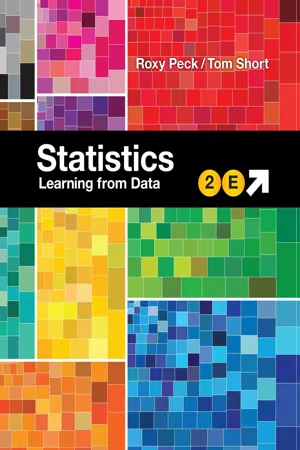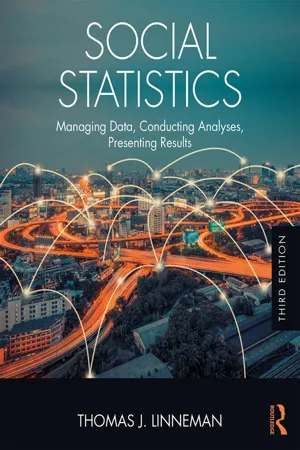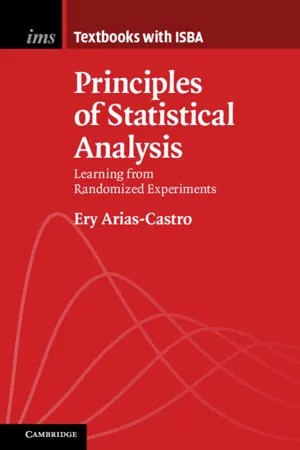Mathematics
Sample Proportion
The sample proportion is a statistical measure that represents the proportion of a specific attribute within a sample. It is calculated by dividing the number of items with the attribute by the total sample size. The sample proportion is often used to estimate the proportion of the attribute in the entire population.
Written by Perlego with AI-assistance
Related key terms
1 of 5
6 Key excerpts on "Sample Proportion"
- Teresa Bradley(Author)
- 2014(Publication Date)
- Wiley(Publisher)
12. State, with explanations whether the following are true or false: (a) A quota controlled sample is used for statistical inference when there is no population list available. (b) Random samples are always unbiased. (c) The Central Limit Theorem applies for any sample size. (d) The standard error decreases as the sample size is increases. 6.2 Sampling distribution of proportions A proportion is the number of elements with a given characteristic divided by the total number of elements in the group. For example, the proportion who votes in an election is the number who actually [ 276 ] C H A P T E R 6 vote divided by the number eligible to vote. In every day situations proportions, when multiplied by 100, are quoted as percentages, for example ‘the percentage unemployed’; ‘the percentage who smoke’; ‘the percentage of home owners’, etc. Since the population proportion is estimated by a Sample Proportion each is represented by different symbols. See Table 6.4: Table 6.4 Symbols for population proportions and Sample Proportions Population characteristic Sample characteristic Size N = number in population n = number in Sample Proportion π = X N (6.5) X is the number of elements with a given characteristic in a population size N p = x n (6.6) x is the number of elements with a given characteristic in a sample size n The Sample Proportion, p is a point estimate of the population proportion, π . To gain some insight into the variation in values among Sample Proportions, return to the small population of five numbers used earlier for sample means, but this time consider the proportion of even numbers: A B C D E 3 1 5 6 2 The population proportion of even numbers, π = 2 5 = 0.4. From this population take every possible sample of (a) size 2 (b) size 3 and calculate the Sample Proportion of even numbers. See Table 6.5. From the Sample Proportions, calculate the mean and standard deviation of the 10 Sample Proportions in (a) and (b).- eBook - PDF
Statistics
Learning from Data
- Roxy Peck, Tom Short(Authors)
- 2018(Publication Date)
- Cengage Learning EMEA(Publisher)
a. Is the number that appears in boldface in this statement a Sample Proportion or a population proportion? b. Which of the following use of notation is correct, p 5 0.45 or ˆ p 5 0.45? 8.14 Consider the following statement: A county tax assessor reported that the proportion of prop-erty owners who paid 2016 property taxes on time was 0.93 . a. Is the number that appears in boldface in this statement a Sample Proportion or a population proportion? b. Which of the following use of notation is correct, p 5 0.93 or ˆ p 5 0.93? HISTOGRAMS FOR EXERCISE 8.7 0.0 0.10 0.15 0.20 0.25 0.30 0.35 0.20 0.15 0.10 0.5 Relative frequency Sample Proportion for samples of size 40 0.0 0.10 0.15 0.20 0.25 0.30 0.35 0.20 0.15 0.10 0.5 Relative frequency Sample Proportion for samples of size 70 Copyright 2019 Cengage Learning. All Rights Reserved. May not be copied, scanned, or duplicated, in whole or in part. Due to electronic rights, some third party content may be suppressed from the eBook and/or eChapter(s). Editorial review has deemed that any suppressed content does not materially affect the overall learning experience. Cengage Learning reserves the right to remove additional content at any time if subsequent rights restrictions require it. 409 8.2 The Sampling Distribution of a Sample Proportion HISTOGRAMS FOR EXERCISE 8.12 0.25 0.20 0.15 0.10 0.5 0.0 Relative frequency Sample Proportion for samples of size 35 0.05 0.10 0.15 0.20 0.25 0.30 0.25 0.20 0.15 0.10 0.5 0.0 Relative frequency Sample Proportion for samples of size 110 0.05 0.10 0.15 0.20 0.25 0.30 Sometimes you want to learn about the proportion of individuals or objects in a population that possess a particular characteristic. For example, you might be interested in the proportion of smartphones that possess a particular manufacturing flaw, the proportion of registered voters who support a particular political candidate, or the proportion of coffee drinkers who prefer decaffeinated coffee. - eBook - PDF
- Jessica Utts(Author)
- 2014(Publication Date)
- Cengage Learning EMEA(Publisher)
• The Rule for Sample Proportions describes the pattern (frequency curve) of sam-ple proportions that would result from taking repeated samples of the same size. The rule says that these Sample Proportions would have a bell-shaped frequency curve with the mean equal to the actual population proportion. The standard devia-tion depends on the sample size and decreases as the sample size increases. • For measurement variables, the sample mean can be used to estimate the popula-tion mean for the population the sample represents. .339 .39 .441 Possible Sample Proportions Figure 19.8 Likely sample propor-tions who voted, if polls of 800 are taken from a population in which .39 (39%) voted Unless otherwise noted, all content on this page is © Cengage Learning. Copyright 2014 Cengage Learning. All Rights Reserved. May not be copied, scanned, or duplicated, in whole or in part. Due to electronic rights, some third party content may be suppressed from the eBook and/or eChapter(s). Editorial review has deemed that any suppressed content does not materially affect the overall learning experience. Cengage Learning reserves the right to remove additional content at any time if subsequent rights restrictions require it. Copyright 2014 Cengage Learning. All Rights Reserved. May not be copied, scanned, or duplicated, in whole or in part. Due to electronic rights, some third party content may be suppressed from the eBook and/or eChapter(s). Editorial review has deemed that any suppressed content does not materially affect the overall learning experience. Cengage Learning reserves the right to remove additional content at any time if subsequent rights restrictions require it. CHAPTER 19 The Diversity of Samples from the Same Population 423 • The Rule for Sample Means describes the pattern (frequency curve) of sample means that would result from taking repeated samples of the same size. - eBook - ePub
Social Statistics
Managing Data, Conducting Analyses, Presenting Results
- Thomas J. Linneman(Author)
- 2021(Publication Date)
- Routledge(Publisher)
Chapter 5Using a Sample Mean or Proportion to Talk About a Population
Confidence Intervals
DOI: 10.4324/9781003220770-5This chapter covers …- … building a probability distribution of sample means
- … how to find and interpret the standard error of a sampling distribution
- … what the Central Limit Theorem is and why it is important
- … population claims and how to put them to the test
- … how to build and interpret confidence intervals
- … how a researcher used confidence intervals to study transgender health inequality
- … how researchers used confidence intervals to study Uber and traffic fatalities
Introduction
In this chapter, we continue our exploration of inference, going through some procedures that you will find strikingly similar to those in the chi-square chapter. Whereas in the chi-square chapter, we dealt with variables of the nominal or ordinal variety, here we deal with ratio-level variables. Our attention turns away from sample crosstabs and toward sample means (and, at the end of the chapter, proportions). But keep in mind that the inference goal remains the same: we will use sample means in order to make claims about population means. Just as we talked about the chi-square probability distribution, we’ll start this chapter with a distribution of sample means.Sampling Distributions of Sample Means
Imagine a hypothetical class with 100 students in it. These students will serve as our population: it is the entire group of students in which we are interested. They get the following hypothetical grades:Here is a bar graph of this frequency distribution:Exhibit 5.1 Grades for a Population of 100 Students: Frequency DistributionGrade # of Students Receiving This Grade 1.0 1 1.1 1 1.2 1 1.3 2 1.4 2 1.5 2 1.6 2 1.7 3 1.8 3 1.9 3 2.0 4 2.1 4 2.2 5 2.3 6 2.4 7 2.5 8 2.6 7 2.7 6 2.8 5 2.9 4 3.0 4 3.1 3 3.2 3 3.3 3 3.4 2 3.5 2 3.6 2 3.7 2 3.8 1 3.9 1 4.0 1 Source: Hypothetical data. - eBook - ePub
Social Statistics
Managing Data, Conducting Analyses, Presenting Results
- Thomas J. Linneman(Author)
- 2017(Publication Date)
- Routledge(Publisher)
Chapter 5 Using a Sample Mean or Proportion to Talk About a Population Confidence IntervalsThis chapter covers ...
- . . . building a probability distribution of sample means
- . . . how to find and interpret the standard error of a sampling distribution
- . . . what the Central Limit Theorem is and why it is important
- . . . population claims and how to put them to the test
- . . . how to build and interpret confidence intervals
- . . . how a researcher used confidence intervals to study popular films
- . . . how researchers used confidence intervals to study Uber and traffic fatalities
Introduction
In this chapter we continue our exploration of inference, going through some procedures that you will find strikingly similar to those in the chi-square chapter. Whereas in the chi-square chapter we dealt with variables of the nominal or ordinal variety, here we deal with ratio-level variables. Our attention turns away from sample crosstabs and toward sample means (and, at the end of the chapter, proportions). But keep in mind that the inference goal remains the same: we will use sample means in order to make claims about population means. Just as we talked about the chi-square probability distribution, we’ll start this chapter with a distribution of sample means.Sampling Distributions of Sample Means
Imagine a hypothetical class with 100 students in it. These students will serve as our population: it is the entire group of students in which we are interested. They get the following hypothetical grades:■ Exhibit 5.1: Grades for a Population of 100 Students: Frequency DistributionHere is a bar graph of this frequency distribution:Grade # of Students Receiving This Grade 1.0 1 1.1 1 1.2 1 1.3 2 1.4 2 1.5 2 1.6 2 1.7 3 1.8 3 1.9 3 2.0 4 2.1 4 2.2 5 2.3 6 2.4 7 2.5 8 2.6 7 2.7 6 2.8 5 2.9 4 3.0 4 3.1 3 3.2 3 3.3 3 3.4 2 3.5 2 3.6 2 3.7 2 3.8 1 3.9 1 4.0 1 Source: Hypothetical data. - eBook - PDF
Principles of Statistical Analysis
Learning from Randomized Experiments
- Ery Arias-Castro(Author)
- 2022(Publication Date)
- Cambridge University Press(Publisher)
If you were that individual, propose a stopping rule that would (artificially) bend the outcome of the experiment in your favor if, not knowing any better, the experimenter analyzes the outcome as if the sample size had been predetermined. Perform some numerical experiments to evaluate your strategy. 14.5 Additional Problems Problem 14.21 (Proportion test) In the context of the binomial experiment of Example 12.2, a proportion test can be defined based on the fact that the Sample Proportion is approximately normal (Theorem 5.4). Based on this, obtain a p-value for testing θ ∗ ≤ θ 0 . Note that the p-value will only be valid in the large-sample limit. (In R, this test is implemented in the prop.test function.) 202 One Proportion Problem 14.22 (A comparison of confidence intervals) A numerical comparison of various confidence intervals for a proportion is presented in [137]. Perform simulations to reproduce Table I, rows 1, 3, and 5, in the article. [Of course, due to randomness, the numbers resulting from your numerical simulations will be a little different.] Problem 14.23 Detail the calculations (implicitly) done in the “Feedback Experiments” section of the paper [43]. 15 Multiple Proportions When a die with m faces is rolled, the result of each trial can take one of m possible values. The same is true in the context of an urn experiment, when the balls in the urn are of m different colors. Such models are broadly applicable. Indeed, even ‘yes/no’ polls almost always include at least one other option like ‘not sure’ or ‘no opinion’. See Table 15.1 for an example. These data can be plotted, for instance, as a bar chart or a pie chart, as shown in Figure 15.1. Table 15.1 Washington Post – ABC News poll of 1003 adults in the US (March 7–10, 2012).
Index pages curate the most relevant extracts from our library of academic textbooks. They’ve been created using an in-house natural language model (NLM), each adding context and meaning to key research topics.





